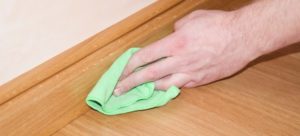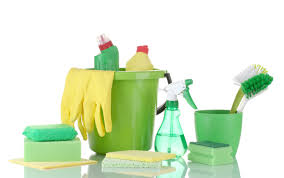A Practical Guide to Keeping Fresher Home
Judging by the flurry of year-end pieces I’ve seen about decluttering, many of us started 2017 with the same resolution; to keep a cleaner, neater home. There are plenty of resources out there on how to declutter, but much less information on how to clean in a systematic and efficient way. The American Cleaning Institute provides some great guidelines on mastering some of the most common cleaning chores, plus how and when do to them.
Start at the top: Using a dust mop made for the job, begin at ceiling level and get rid of any cobwebs or dust motes that have gathered on your doorjambs and moldings.
Curtains and draperies are huge dust catchers. If you smoke or frequently use your fireplace, the odors and soot generated will stick to them, too. Starting at the top, vacuum window treatments like curtains and screens, as well as moldings and windowsills. Depending on your sensitivity to dust, pollen, and other allergens, draperies and curtains should be cleaned either every year or every other year. Check the care labels before tossing them in the washer; it’s a poor economy to ruin expensive window treatments for the price of dry cleaning.
If you have wood, vinyl or metal blinds: clean them often by vacuuming with the brush attachment. Vacuum across the slats, not up and down. Use a dry sponge or a lamb’s wool duster for a heavier cleaning, going across the slats and starting at the top. Metal or vinyl blinds can be washed in the bathtub, one set at a time, using a soft brush or sponge and a mild solution of warm water and Dawn dish soap. Once rinsed, allow them to dry on a layer of towels, then rehang them to finish the drying process.
Wooden furniture: should be dusted weekly with a soft cloth, using furniture polish to protect against scratching.
Upholstered furniture: should be vacuumed weekly, and cushions swept underneath. Always use coasters under beverage glasses, cups, and flowerpots to prevent water spots and rings on wood surfaces. Upholstered furniture should be vacuumed weekly. If you need to remove soil or stains from upholstery, there are lots of cleaning products available – but beware; not all fabrics are cleaning-friendly, and it’s important to test the product in an inconspicuous spot before attacking the whole piece. Washable slipcovers should be laundered as needed according to manufacturer’s directions, and then replaced on furniture while they’re still slightly damp from the dryer.
Now, onto the floors: Keep mats at every exterior doorway to catch dirt before it gets into the house – and keep the mats themselves clean. Vacuum once a week, against the carpet’s nap, taking at least six to eight strokes over each area. Don’t forget to shift the furniture and get underneath it where dust gathers. Carpets can be spot cleaned with commercial products, if needed – but again, test it on a small, inconspicuous area before you use the product on your whole carpet. The Carpet and Rug Institute recommends having your carpets professionally steam cleaned every 12 to 18 months. If you opt to rent a commercial at-home carpet cleaner, don’t over-wet the carpeting, as this can cause damage to the floor beneath and extend the carpet’s drying time, encouraging the growth of microorganisms.
Dust hardwood and other hard-surface flooring weekly: using a dust mop, making sure to shake it out or replace the disposable head as often as it’s soiled. Use appropriate cleaning products to damp mop when needed (at least every two weeks), but do read the label before applying. Not every product is suited to every surface.
 A monthly pass over your woodwork: door surfaces, baseboards, and doorjambs – can be done with a mild cleaner and a sponge, to get rid of sticky fingermarks. Spray glass cleaners on a cloth instead of directly on a mirror or picture glass. This will keep the cleaner away from the frame and prevent it from seeping onto a picture.
A monthly pass over your woodwork: door surfaces, baseboards, and doorjambs – can be done with a mild cleaner and a sponge, to get rid of sticky fingermarks. Spray glass cleaners on a cloth instead of directly on a mirror or picture glass. This will keep the cleaner away from the frame and prevent it from seeping onto a picture.
If you have a fireplace and use it regularly: a professional annual cleaning by a chimney sweep is essential. Deposits left by burning wood in the flue can cause a chimney to catch fire, and a dirty chimney is a smoky chimney. During the fireplace season, clean the ashes out of your  hearth regularly to increase the draft and make your fireplace burn more efficiently.
hearth regularly to increase the draft and make your fireplace burn more efficiently.
In the bathroom: Showers, toilets, sinks, and floors should be cleaned weekly with disinfectant/antibacterial products. Only products that have an EPA registration number on the label have met government requirements for killing germs. Attack the grout monthly with the appropriate cleaning product, and use a daily shower spray to combat mildew on walls and shower curtains. Modern tubs and sinks can be easily scratched by harsh cleansers, so use one formulated for gentle cleaning with less abrasion. Check the labels on the cleaners you’re using to be sure they fight mildew; and use a soap scum remover for that bathtub ring. Glass requires a product formulated specifically for glass to prevent streaking. Keep shower doors and curtains open after use to allow them to air dry and prevent mildew.
And remember, safety first: Store your cleaning products in an area not accessible to children or pets, and away from food. Don’t mix cleaning products, as you may inadvertently create dangerous fumes.

